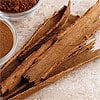
What's Hot
What's Hot
News flashes are posted here frequently to keep you up-to-date with the latest advances in health and longevity. We have an unparalleled track record of breaking stories about life extension advances.
Cinnamon extract slows disease progression in animal model of Alzheimer’s
In an in vitro experiment, Professor Michael Ovadia of Tel Aviv University’s Department of Zoology and his colleagues found that an active fraction of cinnamon bark called CEppt inhibited the formation of amyloid polypeptide oligomers and fibrils that are found in the plaque that occurs in the brains of those afflicted by Alzheimer’s disease. When CEppt was tested in flies that were genetically modified to express human amyloid beta in their nervous system, survival increased to a level experienced by flies that did not express the modified gene and locomotive defects were reduced. CEppt was subsequently tested in mice bred to develop the formation and deposition of amyloid beta, which causes the animals to exhibit cognitive impairment and neuron death. The animals were divided to receive drinking water enhanced with CEppt or plain water for 120 days, after which cognitive abilities and brain changes were assessed. A group of normal mice were used as controls. At the end of the treatment period, the Alzheimer’s disease model mice that received CEppt had activity and survival levels comparable to the control animals, a decrease in amyloid beta oligomers and plaque, and improved cognitive behavior. Dr Ovadia believes that the current findings suggest that CEppt could help reverse the course of Alzheimer’s disease as well as prevent it. "The discovery is extremely exciting,” Dr Ovadia enthused. “While there are companies developing synthetic Alzheimer’s disease inhibiting substances, our extract would not be a drug with side effects, but a safe, natural substance that human beings have been consuming for millennia." —D Dye
Calcium and vitamin D could halve the chance of developing melanoma among women at risk
The study utilized data from 36,000 participants the Women’s Health Initiative calcium plus vitamin D trial. Half of the women were given 1,000 milligrams and 400 international units of vitamin D, while the remainder received a placebo. The women were followed for an average of seven years, during which 176 cases of melanoma were reported. Although no reduction in the risk of melanoma was observed in association with calcium and vitamin D among women without a history of non-melanoma skin cancers, for those with a history of the cancers, supplementation with the nutrients was associated with a 57 percent lower risk compared to the placebo group. The absence of a protective effect for the nutrients in those with no history of non-melanoma skin cancers could be due to the low dose of vitamin D administered in this study, according to the authors. "Our results include the first positive cancer-reducing effect seen from the calcium plus vitamin D trial," announced coauthor Teresa Fu, MD, who is a recent graduate of the School of Medicine. "In preventive medicine, we want to target people most at risk for the disease," stated Dr Tang. "If you previously had a non-melanoma skin cancer, calcium plus vitamin D might reduce your risk of the more deadly melanoma." "These results spur us to do more studies." —D Dye
Increased consumption of cruciferous vegetables linked with lower risk of dying over a decade
Researchers at Vanderbilt University School of Medicine and Shanghai Cancer Institute analyzed data from 61,436 subjects enrolled in the Shanghai Men’s Health Study and 73,360 participants in the Shanghai Women’s Health Study. Questionnaires administered upon enrollment provided information on the intake of fruit and vegetables, including cruciferous vegetables. Over an average follow-up period of 4.6 years, 1,951 deaths occurred in the Shanghai Men’s Study, and 3,442 deaths occurred in the Shanghai Women’s Health Study group over a 10.2 year average. Greater intake of fruit and vegetables was associated with a decreased risk of dying for both men and women. Cruciferous vegetables emerged as particularly protective against the risk of death, with a 22 percent lower risk of dying experienced by subjects whose intake was among the highest one-fifth compared to those whose intake was lowest. When deaths were examined by cause, men and women whose intake of cruciferous vegetables was highest had 31 percent lower adjusted risk of dying from cardiovascular disease compared to those whose intake was lowest. In their discussion of possible mechanisms of action for fruit and vegetables, the authors remark that the vitamins, minerals, fiber and phytochemicals contained therein may affect health via multiple pathways. Sulforaphane, contained in cruciferous vegetables, can help lower oxidative stress and inflammation in the cardiovascular system. “Our findings based on two large cohorts of Chinese women and men support the recommendation to increase consumption of fruit and vegetables, particularly cruciferous vegetables, to promote cardiovascular health and overall longevity,” they conclude. —D Dye
Omega-3 fatty acids boost blood thinning therapy
In a double-blinded trial, 54 men and women whose heart disease was stabilized after undergoing angioplasty with stent implantation were randomized to receive the antiplatelet drug clopidogrel along with omega-3 fatty acids (460 milligrams EPA plus 380 milligrams DHA) or a placebo, in addition to ongoing aspirin therapy. Blood samples were analyzed for clotting and other factors at the beginning of the study, upon discharge from the hospital three to five days after the procedure, and after one month on the regimens. At the end of the four-week treatment period, participants who received omega-3 fatty acids had 15.3 percent greater plasma fibrin clot permeability (which indicates larger pores in the fibrin network), and a 14.3 percent reduction in the time needed for clots to break up compared to the placebo group. Those who received omega-3 also experienced a reduction in other clotting factors (with the exception of fibrinogen), and decreased plasma 8-isoprostaglandin F2-alpha, a marker of oxidative stress. “The current study is the first to demonstrate that omega-3 PUFA added to standard dual antiplatelet therapy after percutaneous coronary intervention favorably alter plasma clot properties compared with placebo,” the authors announce. They add that “This is the first report to demonstrate that in patients with coronary artery disease receiving modern pharmacotherapy, omega-3 PUFA decrease 8-isoprostane formation during nonenzymatic arachidonic acid peroxidation in vivo which suggests that these agents may suppress oxidative stress-mediated adverse effects in coronary artery disease patients, including dense fibrin clot formation.” “These findings indicate novel antithrombotic effects induced by omega-3 PUFA in humans,” they conclude. —D Dye
More omega-3 fatty acid intake better to prevent heart disease deaths
Canadian researchers sought to determine whether an amount greater than 250 milligrams per day omega-3 fatty acids, which is the level recently determined as cardioprotective by the European Food Safety Authority, is associated with an increased reduction in the risk of fatal or nonfatal coronary events (such as heart attack) in men and women without a history of heart disease. Seven cohort studies and one case-control study which quantified long-chain omega-3 fatty acid intake were selected for the analysis. The team concluded that consuming amounts of 250 milligrams per day or more was associated with a 35.1 percent reduction in the risk of sudden cardiac death and a 16.6 percent reduction in total fatal coronary events (considered near significant) in comparison with lower amounts. Although omega-3 intake of greater than 250 milligrams per day was not found to be associated with a reduction in the risk of nonfatal coronary events in the current analysis, the authors remark that "data from prospective observational and intervention studies in Japan indicate that omega-3 LCFA intakes of approximately 900 to 1000 milligrams per day may protect against the risk of non-fatal coronary events in subjects free of known coronary heart disease at baseline. The present evidence suggests that 250 milligrams per day of the omega-3 LCFA should be considered a minimum target intake and not an absolute target intake." —D Dye
Chilling out helps insomniacs
Eric Nofzinger and Daniel Buysee of the University of Pittsburgh tested the cooling cap on 12 men and women with primary insomnia and 12 healthy control patients. They found that the cooling treatment reduced the time it took those with insomnia to fall asleep to a mere 13 minutes, which was three minutes less than it took the control patients to doze off. Both groups spent an average of 89 percent of their time in bed asleep. The authors explain that a reduction in brain frontal cortex metabolism occurs while falling asleep, however insomnia is associated with increased metabolism in this area. Creating cerebral hypothermia reduces metabolic activity, thus improving restorative sleep. "The most significant finding from this study is that we can have a beneficial impact on the sleep of insomnia patients via a safe, non-pharmaceutical mechanism that can be made widely available for home use by insomnia sufferers," stated Dr Nofzinger. "The primary medical treatment for insomnia has long been the prescription of hypnotics, or sleeping pills, yet only about 25 percent of patients using these treatments are satisfied, citing concerns regarding side effects and the possibility of dependence on a pill to help them sleep at night. There exists a large gap between what patients with insomnia are looking for to help them and what is currently available. Patients have long sought a more natural, nonpharmaceutical means to help them with their sleep at night. The identification of a dose-dependent improvement by the device used in this study opens the door to a novel, safe and more natural way to achieve restorative sleep in insomnia care." —D Dye
Apple peel compound helps maintain muscle
"Muscle atrophy causes big problems,” noted senior author Christopher Adams, MD, PhD, who is an endocrinologist at the University of Iowa. “It's also very common -- it affects most people at some point in their lives, during illness or aging. But, there's no medicine for it.” "We studied muscle gene activity in people with atrophy and used that information to find chemicals that might block atrophy,” he explained. “One of those chemicals was especially interesting. It's called ursolic acid and it's particularly concentrated in apple peels.” “We tested ursolic acid in mice, and found that it increased the size and strength of their muscles," Dr Adams reported. "It did this by helping two hormones that build muscle: insulin-like growth factor-1 (IGF1) and insulin. Because ursolic acid increased muscle, it reduced muscle atrophy. Surprisingly, it had some other beneficial effects in mice: for example, it reduced body fat, and lowered blood glucose and cholesterol." The teams’ experiments revealed ursolic acid can help protect muscle from the effects of fasting and nerve damage, which cause weakening. They hope to eventually test ursolic acid in human populations. "We know if you eat a balanced diet like mom told us to eat you get this material," Dr Adams remarked. "People who eat junk food don't get this . . . They always say that an apple a day keeps the doctor away." —D Dye
Mother’s B vitamin use could help protect against cancer in children
Jimmy Crott, PhD and his associates administered female mice diets that were mildly deficient, replete or supplemented with vitamins B2, B6, B12 and folate, beginning four weeks prior to mating the animals with males that were bred to develop colorectal cancer. The diets were continued until the animals’ offspring were weaned. When the pups reached 8 months of age, 59 percent of those whose mothers received deficient diets and 55 percent of those born to mothers that received vitamin-replete diets had tumors, compared to just 21 percent of those whose mothers were supplemented. Additionally, tumors found in mice born to vitamin-deficient mothers were likelier to be invasive. “Although the tumor incidence was similar between offspring of deficient and adequate mothers, 54% of tumors in the deficient offspring were advanced and had invaded surrounding tissue while only 18% of tumors in the offspring of adequate mothers displayed these aggressive properties,” Dr Crott elaborated. “While evidence is beginning to accumulate to suggest that maternal consumption of supplements containing folate may afford some protection against childhood cancers in offspring, we don’t yet have the ability to determine whether the same holds true for cancers that normally present in the mid to late decades of life,” he added. “Aside from the known protective effect of maternal folate against neural tube defects such as spina bifida, our results suggest that mothers consuming supplemental quantities of these B vitamins may also be protecting her children against colorectal cancer.” —D Dye
Endocrine Society releases vitamin D screening guidelines
The Clinical Practice Guideline recommends that infants less than a year old receive 400 international units (IU) per day vitamin D, and that children older than one year receive 600 IU daily to maximize bone health. For these groups, raising serum 25-hydroxyvitamin D levels above 30 nanograms per milliliter (ng/mL) may require more than 1,000 IU per day vitamin D. Six hundred international units per day was recommended for pregnant women and adults aged 19 to 70 for bone health and optimal muscle function, however, this group could need 1,500 to 2,000 IU per day to elevate serum levels above 30 ng/mL. For those over the age of 70, more may be necessary. "Vitamin D deficiency is very common in all age groups and it is important that physicians and health care providers have the best evidence-based recommendations for evaluating, treating and preventing vitamin D deficiency in patients at highest risk," stated Task Force Chair Michael F. Holick, PhD, MD, of Boston University School of Medicine. “The Society's new Clinical Practice Guideline was developed by experts in the field who carefully reviewed the current literature and features the latest and most comprehensive recommendations available on the prevention and treatment of vitamin D deficiency." —D Dye
Ribose, NADH supplements may help children with autism
The report describes the findings of two pilot studies involving supplementation with NADH and ribose separately for two weeks to groups of eight autistic children who exhibited low energy or decreased muscle tone. Levels of glutathione, ATP and 18 biomarkers related to methylation (a function that turns proteins on and off, which is impaired in autism), were measured before and after treatment. Supplementation with either compound was associated with increased methylation. Treatment also elevated the production of ATP as well as glutathione, an antioxidant that helps defend against toxic metals. One child in each group demonstrated improved energy levels after the short course of treatment. No adverse effects were noted. “These therapies appear to be safe and effective supportive therapies for restoring methylation, glutathione and ATP to near-normal levels in the body, and are likely to help children with autism who experience problems maintaining normal functions,” coauthor Stuart Freedenfeld, MD of Stockton Family Practice concluded. Dr Freedenfeld recommends larger and more formal studies to confirm the supplements’ benefits in autistic patients. —D Dye
Supplement combo improves ED symptoms
Twenty-four Japanese men with mild to moderate erectile dysfunction who did not have diabetes or heart disease were selected for the current trial. The participants were divided to receive six tablets per day of a supplement containing 115 milligrams L-arginine, 92 milligrams aspartic acid and 10 milligrams French maritime pine bark extract per tablet, or an equal amount of placebo tablets for 8 weeks. Erectile dysfunction symptoms were scored, and blood, urine and saliva samples were analyzed for numerous factors before treatment and at four and eight weeks. By the end of the study, those who received the nutrient combination had improved erection quality and sexual satisfaction scores, decreased blood pressure and blood glucose, and a small increase in salivary testosterone. No adverse events were observed. In their discussion of the findings, the authors suggest that L-arginine and pine bark extract could increase testosterone via an increase in cyclic guanosine monophosphate as a result of increased nitric oxide production, or by increased blood flow in the testes due to dilation of the peripheral blood vessels. They note the correlations established between low testosterone and lifestyle diseases, and remark that a supplement that increases testosterone levels could be applicable to those diseases as well. "Improvement of sexual intercourse satisfaction is expected to contribute to the improvement in quality of life of subjects, which may in turn positively contribute to overall health" the authors write. "It is desirable that a long-term and large-scale clinical study be conducted in the future to verify the results of this study." —D Dye
Omega-3 fatty acid improves mood in animal model of bipolar disease and alcoholism
Associate professor of psychiatry Alexander B. Niculescu, MD, PhD and his associates gave diets containing low or high amounts of DHA to a group of mice bred to develop bipolar disease symptoms, including depression and a manic response to stress. Behavioral challenge tests were administered three weeks after the beginning of the experiment. "The mice that were given DHA normalized their behavior, they are not depressed and when subjected to stress, they do not become manic," Dr Niculescu reported. "When we looked into their brains, using comprehensive gene expression studies, we were surprised to see that genes that are known targets of psychiatric medications were modulated and normalized by DHA." Mice that received the high DHA diet additionally exhibited a reduction in their desire for alcohol, a finding that was duplicated in a separate experiment with rats. "These bipolar mice, like some bipolar patients, love alcohol,” Dr Niculescu explained. “The mice on DHA drank much less; it curtailed their alcohol abusive behavior. "We believe a diet rich in omega 3 fatty acids may help the treatment and prevention of bipolar disorder, and may help with alcoholism as well," he concluded. "There is now substantial evidence at the molecular level that omega-3 fatty acids work on the brain in ways similar to psychiatric drugs. With these biomarker findings, we can now move forward as a field and do more targeted clinical studies in humans." —D Dye
|

 Research reported this year in the journal
Research reported this year in the journal  In an article published online on June 27, 2011 in the
In an article published online on June 27, 2011 in the  A report published in the July, 2011
A report published in the July, 2011  An article published online on May 26, 2011 in
An article published online on May 26, 2011 in ![More omega-3 fatty acid intake better to prevent heart disease deaths [fish]](/images/secondary/art_whot_112309_story.jpg) A review published online on May 31, 2011 in the
A review published online on May 31, 2011 in the  At the 25th Anniversary Meeting of the Associated Professional Sleep Societies LLC, the finding of improved sleep among insomniacs who don a cap that cools the brain was presented on June 13, 2011.
At the 25th Anniversary Meeting of the Associated Professional Sleep Societies LLC, the finding of improved sleep among insomniacs who don a cap that cools the brain was presented on June 13, 2011.  The June 8, 2011 issue of
The June 8, 2011 issue of  An article published online on June 9 in the journal
An article published online on June 9 in the journal  The
The  An article published online on May 22, 2011 in the journal
An article published online on May 22, 2011 in the journal  The amino acids L-arginine and aspartic acid combined with French maritime pine bark extract were demonstrated to significantly improve
The amino acids L-arginine and aspartic acid combined with French maritime pine bark extract were demonstrated to significantly improve  An article published online on April 26, 2011 in the journal
An article published online on April 26, 2011 in the journal 